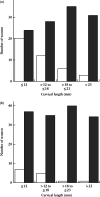Change in cervical length after arrested preterm labor and risk of preterm birth
- PMID: 33860985
- PMCID: PMC8596619
- DOI: 10.1002/uog.23653
Change in cervical length after arrested preterm labor and risk of preterm birth
Abstract
Objective: To assess the association between preterm birth and cervical length after arrested preterm labor in high-risk pregnant women.
Methods: In this post-hoc analysis of a randomized clinical trial, transvaginal cervical length was measured in women whose contractions had ceased 48 h after admission for threatened preterm labor. At admission, women were defined as having a high risk of preterm birth based on a cervical length of < 15 mm or a cervical length of 15-30 mm with a positive fetal fibronectin test. Logistic regression analysis was used to investigate the association of cervical length measured at least 48 h after admission and of the change in cervical length between admission and at least 48 h later, with preterm birth before 34 weeks' gestation and delivery within 7 days after admission.
Results: A total of 164 women were included in the analysis. Women whose cervical length increased between admission for threatened preterm labor and 48 h later (32%; n = 53) were found to have a lower risk of preterm birth before 34 weeks compared with women whose cervical length did not change (adjusted odds ratio (aOR), 0.24 (95% CI, 0.09-0.69)). The risk in women with a decrease in cervical length between the two timepoints was not different from that in women with no change in cervical length (aOR, 1.45 (95% CI, 0.62-3.41)). Moreover, greater absolute cervical length after 48 h was associated with a lower risk of preterm birth before 34 weeks (aOR, 0.90 (95% CI, 0.84-0.96)) and delivery within 7 days after admission (aOR, 0.91 (95% CI, 0.82-1.02)). Sensitivity analysis in women randomized to receive no intervention showed comparable results.
Conclusion: Our study suggests that the risk of preterm birth before 34 weeks is lower in women whose cervical length increases between admission for threatened preterm labor and at least 48 h later when contractions had ceased compared with women in whom cervical length does not change or decreases. © 2021 The Authors. Ultrasound in Obstetrics & Gynecology published by John Wiley & Sons Ltd on behalf of International Society of Ultrasound in Obstetrics and Gynecology.
Keywords: arrested preterm labor; cervical length; change in cervical length; preterm birth; threatened preterm labor.
© 2021 The Authors. Ultrasound in Obstetrics & Gynecology published by John Wiley & Sons Ltd on behalf of International Society of Ultrasound in Obstetrics and Gynecology.
Figures

 ) vs at or after 34 weeks (
) vs at or after 34 weeks ( ) (a) and numbers with delivery within 7 days (
) (a) and numbers with delivery within 7 days ( ) vs after 7 days (
) vs after 7 days ( ) following admission for threatened preterm labor (b), according to cervical length measured at least 48 h after admission.
) following admission for threatened preterm labor (b), according to cervical length measured at least 48 h after admission.
 , Reference line at 10% predicted risk.
, Reference line at 10% predicted risk.
 , Reference line at 10% predicted risk.
, Reference line at 10% predicted risk.
 , Reference line at 10% predicted risk.
, Reference line at 10% predicted risk.References
-
- Liu L, Johnson HL, Cousens S, Perin J, Scott S, Lawn JE, Rudan I, Campbell H, Cibulskis R, Li M, Mathers C, Black RE. Global, regional, and national causes of child mortality: An updated systematic analysis for 2010 with time trends since 2000. Lancet 2012; 379: 2151–2161. - PubMed
-
- Platt MJ. Outcomes in preterm infants. Public Health 2014; 128: 399–403. - PubMed
-
- Gazmararian JA, Petersen R, Jamieson DJ, Schild L, Adams MM, Deshpande AD, Franks AL. Hospitalizations during pregnancy among managed care enrollees. Obstet Gynecol 2002; 100: 94–100. - PubMed
MeSH terms
LinkOut - more resources
Full Text Sources
Other Literature Sources
Medical

